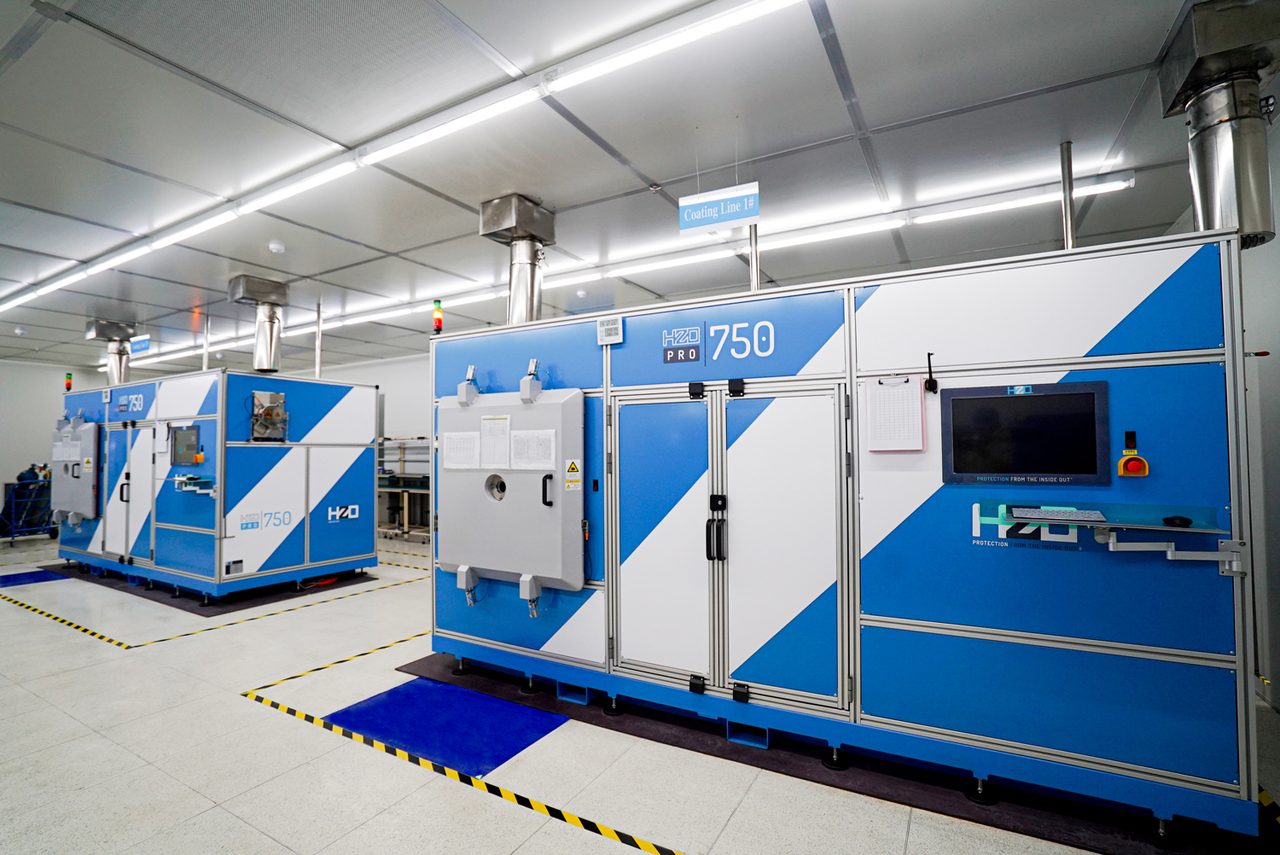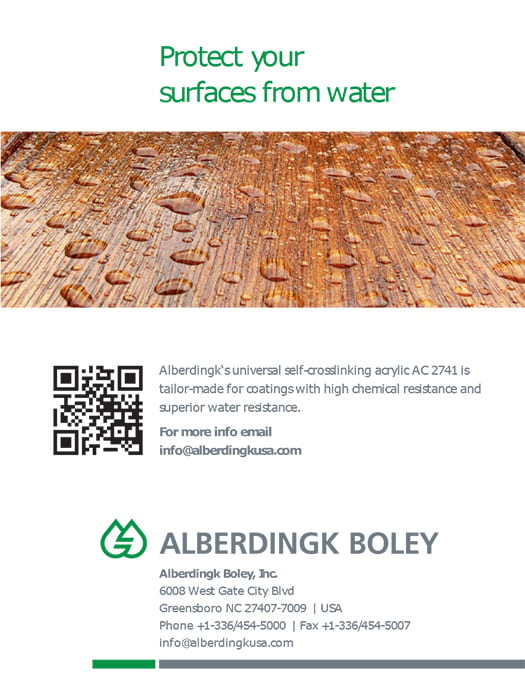Ready to proof -- Clare 03/14/22
KJ proofed on 3/14
Ready for author
KJ made author corrections on 3/18 and resent it to them
CLEAN
Photos cortesy of HZO.
Purposefully Designed Equipment for
Advanced Conformal Coating Applications
By Richard Weiland, Business Director, Nanocoating Applications, HZO, Inc., Raleigh, NC
There was a time when only circuit boards used in mission-critical applications were coated for protection. They were those with the need for stability and durability that went beyond financial considerations or minor inconveniences. Today, the demand for protection and reliability is ubiquitous in commercial and consumer applications across a multitude of industries, including automotive, military, aerospace, IoT, consumer electronics, industrial and medical.
Of the available conformal coating technologies, Parylene can provide the best protective barrier necessary from the environment and corrosion. Parylene conformal coatings are uniquely applied by a chemical vapor deposition process to ensure a consistent coating application. Perfecting the application of Parylene coatings requires process, expertise, chemistry and capital equipment — the latter being critical to repeatable and scalable processes. Nanocoatings company HZO searched worldwide for applicable coating equipment up to that task. Not finding what they needed, they built it. They now have the largest Parylene coating chamber in the industry.
The impediments to parylene's wide adoption have been cost and scalability. The raw materials have been historically high priced, and scalability with manufacturing integration is complex. HZO has broadened the scale of usage for this robust, organic material by making it available to companies and manufacturers that could not previously consider it an option. At the foundation of its offerings are engineers and scientists with deep domain and industry expertise in conformal coatings and its in-house proprietary equipment.
Parylene
Research chemist Michael Szwarc isolated the Parylene polymer series in the late 1940s at the University of Manchester, England. He discovered the polymer as one of the thermal decomposition products of a common solvent, p-xylene, at a temperature between 700-900 °C. Union Carbide scientist William Gorham later developed a deposition process to apply the film. He deposited Parylene films by the thermal decomposition of di-p-xylylene at 550 °C and in vacuum below 1 Torr, a process that did not require a solvent and resulted in chemically resistant films free from pinholes. In 1965, Union Carbide commercialized the material and the chemical vapor deposition (CVD) process that is unique among conformal coatings.
While the barrier properties of Parylene are unmatched, it adds minimal mass to coated surfaces and contributes no cure or thermal expansion forces to threaten delicate components. Parylene has exceptional tensile and yield strength, is dielectric, and can cover the entire board to protect component leads, solder joints, exposed traces and other metalized areas. It provides protection from corrosion, and shields the whole PCBA from spray, moisture, fungus, dust and other contaminations from harsh environments. Parylene even helps prevent damage to circuitry and sensitive components from thermal and mechanical stress as well as rough handling, or in the case of AMRs, bumps and jarring during deployment.
Parylene conformal coatings consist of a protective polymer layer 12-25 µm thick (<20 µm typical) that conforms to a PCBA's shape and components. They provide resistance to solvents and chemicals, are heat resistant, and help prevent light component leakage and corrosion. They are the best protective strategy for PCBA that will be exposed to unfavorable environments.
How the Coating Equipment Was Built
In 2018, HZO acquired ZPL Technologies, a Hungarian and US-based coating equipment design and manufacturing company. The two companies worked together for several years prior to the acquisition, and ZPL Technologies was integral in innovating and producing HZO's proprietary coating and support equipment.

Today, all HZO's coating machines are designed from the ground up, and then developed and manufactured in-house to the most rigorous standards before being deployed to the production floor. They are made to specialize in mass production and can easily scale up to coating hundreds, thousands or millions of electrical sub-assemblies a day.
How It Works
The first steps of the HZO process with a potential customer involve a detailed evaluation of the product to be protected, where the coating process can be introduced in the production flow, and what protection level the customer needs. This evaluation considers the components that require protection and the level of protection required, whether splash resistant, sweatproof, submersible, solvent or corrosion resistance, or operating temperatures and environment. A detailed process plan is developed, and prototype runs occur to test the environmental performance and reliability of the coated customer parts.
There are three distinct steps in the HZO process: pre-process, coating and post-process.
Pre-process: Because CVD coating vapor can penetrate micron-sized gaps, masking may be required for areas of the PCBA or component that should not be coated, such as screens, sensors, lenses, connectors and other components whose functionality may be hampered by coating. Much of HZO's intellectual property is based on innovative materials and processes designed to streamline the masking process, whether for manual masking, semi-automated masking or seamless automated masking. Its masking products and solutions are unique and not found anywhere else in manufacturing.
Coating: Once the masking process is completed, if applicable, products are ready to be coated within the large, efficient cubic coating chambers. Custom tray configurations ensure high throughput and safe handling of the product. They are then placed on racks inside the coating chambers where the coating process commences.
Parylene coating is applied as a single material application. The Parylene raw material, which is a powder form, is added to a vaporizer and sublimed from a solid to a vapor form. The vapor, which is a non-reactive dimer initially, passes into a higher-temperature pyrolyzer, "cracking" the raw material into two activated monomer units.
The coating chamber is under vacuum at room temperature, allowing the vapor to disperse evenly in the chamber. The monomer can flow under and around components before polymerizing, creating a uniform, thin-film polymer barrier around the electrical components being coated.
Post-process: After coating, which may take several hours, parts can be removed from the chamber fully protected — there is no curing or waiting time with Parylene. Masking materials are removed, and parts are inspected to ensure coating is where it needs to be (and nowhere else). Coating thickness can be verified with an optical measurement, and has very tight batch to batch and part to part repeatability.
Conclusion
With its proprietary equipment, HZO removed the most critical roadblocks of the material application by designing and deploying high-throughput coating equipment and automated processing systems for efficient manufacturing. The company is now able to coat millions of parts per day consistently, reliably and competitively.
The precision and control of the systems extend the use of Parylene by meeting tighter tolerances, thinner film depositions and higher quality standards. It employs a proven application method for both small-batch and high-throughput environments.
Since its establishment in 2011, HZO has protected well over 100 million products worldwide. In developing partnerships with manufacturers, product developers, engineers, brands and companies that design, develop and build equipment, HZO introduces its coating technology directly into the design of new products. For companies with their own production capabilities, HZO will directly sell or lease its equipment, install the machine and provide complete training, integration support, and ongoing technical collaboration. For companies and brands sourcing or developing products without manufacturing capabilities, HZO offers a product protection service along with engineering and technical support, and process development for components and boards. In this case, parts would be shipped to an HZO facility where the defined process would be implemented, the parts protected and then returned.
For more information, visit the HZO, Inc. website.
*Photos courtesy of HZO, Inc.
